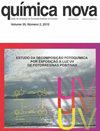纳米银修饰介孔二氧化硅-析因实验对辐射分解合成参数的研究
IF 0.7
4区 化学
Q4 CHEMISTRY, MULTIDISCIPLINARY
引用次数: 0
摘要
耐药的传染性微生物正在引起一个全球性的新问题,称为抗菌素耐药性。为避免这一疫情,有必要采用新的抗菌技术。银纳米粒子(AgNPs)以其抗菌特性而闻名,一些研究集中在它们的合成、表征和生物测定上。合成AgNPs的一种可能性是通过伽马辐射,即辐射分解合成。这项工作的重点是辐射分解合成AgNPs盖成介孔二氧化硅纳米颗粒,旨在抗菌应用。利用Minitab软件中的Design of Experiments析因设计(Factorial Design)对可能影响AgNPs形成的辐射分解合成变异进行了研究和统计比较。Ag含量静态依赖于剂量、体积和pH,以及两个参数相互作用:[Ag+]-pH和[Ag+]-体积-pH相互作用。透射电镜和氮吸附分析表明,亚纳米AgNPS存在于介孔内。透射电镜还发现了银纳米团块,如x射线光电子能谱所示,银纳米团块可能是由氧化银形成的。AgNPs降低了二氧化硅纳米颗粒的比表面积,而基体形态保持不变。在体外成纤维细胞生物实验中观察到纳米复合材料具有初步的生物相容性,支持其作为抗菌替代品在生物系统中的应用。本文章由计算机程序翻译,如有差异,请以英文原文为准。
MESOPOROUS SILICA DECORATED WITH SILVER NANOPARTICLES – AN INVESTIGATION OF THE RADIOLYTIC SYNTHESIS PARAMETERS THROUGH FACTORIAL EXPERIMENTS
Resistant infectious microorganisms are causing a worldwide emerging problem, called antimicrobial resistance. To avoid this outbreak, new antimicrobial technologies are necessary. Silver nanoparticles (AgNPs) are known for their antibacterial properties and several studies have focused on their synthesis, characterization, and biological assays. One possibility to synthesize AgNPs is through gamma radiation, known as radiolytic synthesis. This work focuses on the radiolytic synthesis of AgNPs capped into a mesoporous silica nanoparticle aiming at an antimicrobial application. The variants of the radiolytic synthesis, which may influence the AgNPs formation, were studied and statistically compared by Design of Experiments Factorial Design in Minitab Software. The Ag content is statically dependent on dose, volume, and pH, as well as on two parameters interaction: [Ag+]-pH and [Ag+]-volume-pH interaction. Transmission electron microscopy and nitrogen adsorption analyses indicated the presence of subnanometric AgNPS located inside the mesopores. Silver nanoagglomerates were also found by transmission electron microscopy, which could be formed by silver oxides, as shown in X-ray photoelectron spectroscopy. AgNPs reduce the specific surface area of the silica nanoparticle, while the matrix morphology remains. The nanocomposites presented preliminary biocompatibility observed in in vitro biological assay using fibroblasts, which support their application in biological systems as antimicrobial substitutes.
求助全文
通过发布文献求助,成功后即可免费获取论文全文。
去求助
来源期刊

Quimica Nova
化学-化学综合
CiteScore
1.60
自引率
12.50%
发文量
72
审稿时长
2-4 weeks
期刊介绍:
Química Nova publishes in portuguese, spanish and english, original research articles, revisions, technical notes and articles about education in chemistry. All the manuscripts submitted to QN are evaluated by, at least, two reviewers (from Brazil and abroad) of recognized expertise in the field of chemistry involved in the manuscript. The Editorial Council can be eventually asked to review manuscripts. Editors are responsible for the final edition of QN.
 求助内容:
求助内容: 应助结果提醒方式:
应助结果提醒方式:


